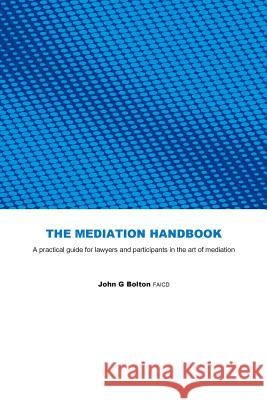The Mediation Handbook: practical guide for lawyers and participants in the art of mediation » książka
The Mediation Handbook: practical guide for lawyers and participants in the art of mediation
ISBN-13: 9781482750737 / Angielski / Miękka / 2013 / 74 str.
Until the early 1990s it was often considered a sign of weakness if a litigating party made overtures to negotiate a settlement. It was also common to see groups of robed barristers outside the doors of various courts, busily trying to settle their cases at the last minute. Parties would hold their cards close to their chest in the hope of catching the other party off guard and last minute applications for adjournment with significant cost penalties were common. We now practice in more enlightened times. Through the process of mediation, courts and tribunals have encouraged parties to mediate and an offer to negotiate is seen more as a sign of strength. Over 60% of all disputes are now settled well before the dreaded 'door of the court'. If they don't settle, at least the parties have had the opportunity to ventilate the issues and reduce the length of trials. All mediations are different with no predictable results. All mediators are different and each has an individual approach. All those participating in mediations are different and have their own agenda. I have set out in this handbook some approaches and tactics which may help lawyers appearing in mediations. None of my suggestions must be followed, in fact there will be circumstances where some of the approaches I refer to are inappropriate and should not be followed. But all of what is contained in this book should cause practitioners to think -about the process, about how to approach mediation, about the direction in which they want the mediation to proceed and about the result they want to achieve for their clients. Most books and seminars about mediation are given from the mediators' perspective - how to be an effective mediator and how mediators should conduct mediations. In this handbook, mediation is approached from the point of view of the lawyers representing the parties and is to serve as a practical guide. The aim of this book is to give legal representatives, be they solicitors or barristers, an insight into how they can best use the mediation process and mediators to resolve disputes for their clients, mitigate costs or improve the chances of success in court should the matter not settle. Mediators may perceive some of my suggestions could make their task more difficult. This is not my intention. I have endeavoured to provide food for thought for those practitioners who want to use the mediation process to their clients' best advantage and who are open to resolving the dispute. My earnest belief is all practitioners have an obligation to approach mediation with a will to settle and should never attempt to obstruct the mediator or the process. Mediation exists within the context of a culture of alternative dispute resolution which has grown in strength within the legal and broader communities to a point where this form of dispute resolution is now commonplace. Courts and Tribunals in Australia now refer most disputes to mediation as part of their normal process, reflecting the preference for early dispute resolution. However many lawyers in mediations have never really considered how to maximise the process for their clients or for themselves. Nor have they, until now, any way of equipping themselves with sufficient knowledge to be effective players in the process. Mediation is an art form which, if conducted properly, will resolve most disputes. At the very least the process will provide a valuable insight into the strengths and weaknesses of each party's case, setting the scene for eventual resolution or narrowing the issues in dispute.
Zawartość książki może nie spełniać oczekiwań – reklamacje nie obejmują treści, która mogła nie być redakcyjnie ani merytorycznie opracowana.











